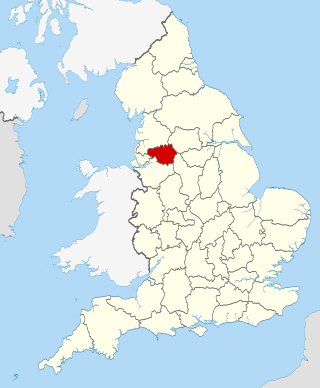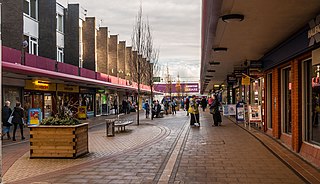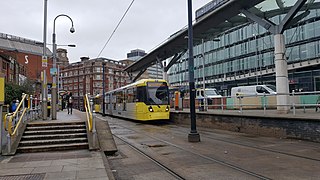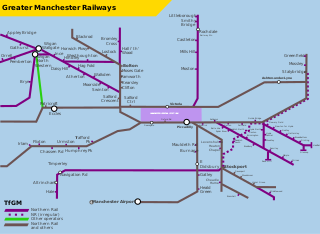
Transport for Greater Manchester (TfGM) is a local government body responsible for co-ordinating transport services throughout Greater Manchester in North West England. It is an executive arm of the Greater Manchester Combined Authority (GMCA), the city region's administrative authority. The strategies and policies of Transport for Greater Manchester are set by the GMCA and its Greater Manchester Transport Committee (GMTC). The committee is made up of 33 councillors appointed from the ten Greater Manchester boroughs, as well as the Mayor of Greater Manchester.

Swinton is a town in the City of Salford in Greater Manchester, England. southwest of the River Irwell, 4 miles (6.4 km) northwest of Manchester, adjoining the town of Pendlebury and suburb of Clifton. In 2014, it had a population of 22,931.

Salford Crescent railway station is a railway station in Salford, Greater Manchester, England, opened by British Rail in 1987.

Free bus is a zero-fare bus system that operates in Greater Manchester. The system was first introduced in Manchester city centre in 2002, with three routes linking the city's major thoroughfares and stations with its main commercial, financial and cultural districts.

The Manchester–Southport line is a railway line in the north-west of England, operated by Northern Trains. It was originally built as the Manchester and Southport Railway. The section between Wigan and Salford is also known locally as the Atherton Line.

Hindley railway station is a railway station that serves the town of Hindley in Greater Manchester, England. It is on the Manchester to Southport line, west of where the route branches to use either the Atherton line or the Eastern Branch line via Westhoughton, Lostock and Bolton.

Manchester Piccadilly Gardens bus station, often abbreviated to Piccadilly Gardens, is one of two main bus stations in Manchester city centre.

Walkden is a town in the City of Salford in Greater Manchester, England, six miles northwest of central Salford, and seven miles of Manchester.

Shudehill Interchange is a transport hub between Manchester Victoria station and the Northern Quarter in Manchester city centre, England, which comprises a Metrolink stop and a bus station.

The transport infrastructure of Greater Manchester is built up of numerous transport modes and forms an integral part of the structure of Greater Manchester and North West England – the most populated region outside of South East England which had approximately 301 million annual passenger journeys using either buses, planes, trains or trams in 2014. Its position as a national city of commerce, education and cultural importance means the city has one of the largest and most thorough transport infrastructures which is heavily relied upon by its 2.8 million inhabitants in the Greater Manchester conurbation and further afield in the North West region. Public transport comes under the jurisdiction of Transport for Greater Manchester.

The Wilmslow Road bus corridor is a 5.5-mile-long section of road in Manchester that is served by a large number of bus services. The corridor runs from Parrs Wood to Manchester city centre along Wilmslow and Oxford Roads, serving Didsbury, Withington, Fallowfield and Rusholme.

Greater Manchester bus route 192 is a high frequency bus route runs between Hazel Grove in the Metropolitan Borough of Stockport and Piccadilly Gardens in Manchester city centre. It is operated by Stagecoach Manchester.

Between 1901 and 1949 Manchester Corporation Tramways was the municipal operator of electric tram services in Manchester, England. At its peak in 1928, the organisation carried 328 million passengers on 953 trams, via 46 routes, along 292 miles (470 km) of track.

Greater Manchester bus route 43 operates in Greater Manchester between Manchester Piccadilly Gardens bus station and Manchester Airport.

Greater Manchester Passenger Transport Executive was the public body responsible for public transport in Greater Manchester between 1974 and 2011, when it became part of Transport for Greater Manchester.

The Manchester station group is a station group of four railway stations in Manchester city centre, England; this consists of Manchester Piccadilly, Manchester Oxford Road, Manchester Victoria and Deansgate. The station group is printed on national railway tickets as MANCHESTER STNS. For passengers travelling from one of the 91 National Rail stations in Greater Manchester, the four stations are printed as MANCHESTER CTLZ which additionally permits the use of Metrolink tram services in Zone 1.

The Leigh-Salford-Manchester Bus Rapid Transit scheme in Greater Manchester, England provides transport connections between Leigh, Atherton, Tyldesley, Ellenbrook and Manchester city centre via Salford. The guided busway and bus rapid transit (BRT) scheme promoted by Transport for Greater Manchester (TfGM) opened on 3 April 2016. Built by Balfour Beatty at a total cost of £122 million to improve links from former Manchester Coalfield towns into Manchester city centre, the busway proposal encountered much opposition and a public enquiry in 2002 before construction finally started in 2013. A branch route from Atherton, and an extension to the Manchester Royal Infirmary have been added to the planned original scheme.

Zone 1 of the Manchester Metrolink light rail network is the heart of the system where all of the other lines converge. Its boundaries approximately mirror the city's Inner Ring Road. Within Zone 1, first opened in 1992 as the City Zone, trams largely run along semi-pedestrianised streets rather than on their own separate alignment.
The Bee Network is an integrated transport network for Greater Manchester, comprising bus, tram, cycling and walking routes. Transport for Greater Manchester (TfGM) is expected to have the network operational by 2025, with commuter rail services expected to be joining the network in 2028. Initially revealed in 2018, the project is aiming to create a London-style transport system, to encourage more people to take public transport instead of cars.

Greater Manchester bus route 135 is a Bee Network bus route runs between Piccadilly Gardens in the Manchester city centre and Bury Interchange. It is operated by Stagecoach Manchester on contract from Transport for Greater Manchester.



















